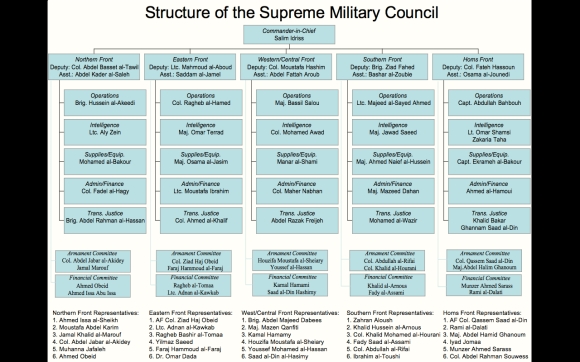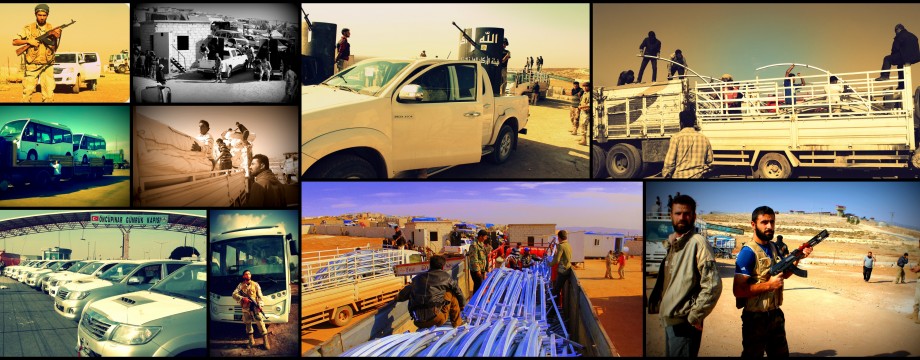Understanding the Supreme Military Council
The Military Branch of Syria’s Future SOC-led Transitional Government
________ ________ ________
On December 15th, representatives of the Syrian opposition’s revolutionary and military council commands issued a statement announcing the formation of the Supreme Military Council, the military wing of the Syrian Opposition Coalition and the future SOC-led transitional government. All officials of the Council–major and subordinate, military and civilian–were elected to their positions by a 261-member body known as the Revolutionary Force Authority.
The Council is structured to represent each of Syria’s five different battle fronts (Northern, Southern, Eastern, Western/Central, and Homs). The Council is led by Commander-in-Chief Salim Idriss. To support and advise his efforts, five military deputies and five civilian assistant deputies were appointed to head each of the five specific battle fronts. Each team of deputies from each front are assisted by five sub-councils, each serving a different function (Operations, Intelligence, Supplies and Equipment, Administrative and Finance, and Transitional Justice). In addition to these sub-councils, each front has two subcommittees (Armament and Financial).
The diagram below represents Syrian Support Group’s understanding of the final structure of the Supreme Military Council.
(click diagram to enlarge)
 The following are the “Rights and Duties” of the Supreme Military Council:
The following are the “Rights and Duties” of the Supreme Military Council:
- The Supreme Military Council Command is considered the highest military authority in the Syrian Arab Republic.
- The minister of defense [once elected in the future SOC-led transitional government] is the head of the Supreme Military Council Command.
- Appointing the commander-in-chief. The Council has the right to accept his resignation or remove him in the event of incompetence. The latter requires a two-thirds majority vote in favor.
- Nominating five names for the minister of defense and five for the minister of interior. The prime minister makes the final selection from these options [once elected in the future SOC-led transitional government].
- Appointing a legal committee tasked with appointing members of the joint revolutionary military force authority.
- Establishing the military strategy and policies aimed at toppling the regime.
- Overseeing the distribution of weapons and funds to the five fronts.
- Tasking the central command with preparing plans for military operations, and overseeing their execution.
- Overseeing the work of the central command and all forces under it.
- Protecting the revolution, national assets, and the sovereignty of the Syrian Arab Republic.
- Maintaining and protecting the internal security of the country by overseeing all revolutionary intelligence and security bodies.
- Protecting the assets and properties of the Syrian people.
- Accepting or rejecting the resignation of any member of the Supreme Military Council Command and replacing them as needed.
- Mandating and amending internal regulations and administrative and financial systems.
- In consultation with the commander-in-chief, the Council has the right to remove any military member from the Council in the event that dereliction of duty or inefficacy is proven.
- Proposing a military rank, an honorary status or a promotion for an officer to the prime minister for approval (as recommended by the Council).
- This Council is the only authority mandated to form the Syrian Arab Army after the fall of the regime.
- The Council is not to allow international trials for any revolutionaries who carried a weapon against the regime. Such cases should be referred to a fair Syrian trial.
What does this mean for Syria, the U.S., and the international community?
When the Supreme Military Council is fully integrated into the Syrian Opposition Coalition (SOC), it is likely that two things will occur simultaneously. First, the SOC will begin to gain significantly more support from Syrians on the ground. The presence of armed opposition forces organizing in the Coalition will signal to fighters and civilians alike that the SOC, unlike its ineffective and impotent predecessor SNC, is developing the most immediate function necessary for ending the conflict–an organized and functional military command. Secondly, the international community will recognize that the SOC is gaining legitimacy, leading countries like the U.S. to, at most, upgrade their recognition of the SOC, or, at least, feel more comfortable that any future supplies that may be sent to armed opposition units will be disseminated through an organized politico-military structure and sent to moderate non-Islamist units.
Meanwhile, the SOC envoy to the Unites States, Najib al-Ghadban, is in Washington to discuss with the U.S. government the current scope of the recognition it has granted the SOC.
